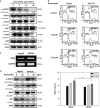Simvastatin-induced cell cycle arrest through inhibition of STAT3/SKP2 axis and activation of AMPK to promote p27 and p21 accumulation in hepatocellular carcinoma cells
- PMID: 28230855
- PMCID: PMC5386458
- DOI: 10.1038/cddis.2016.472
Simvastatin-induced cell cycle arrest through inhibition of STAT3/SKP2 axis and activation of AMPK to promote p27 and p21 accumulation in hepatocellular carcinoma cells
Abstract
Hepatocellular carcinoma (HCC) is characterized by a poor prognosis and is one of the leading causes of cancer-related death worldwide. Simvastatin, an HMG-CoA reductase inhibitor, which decreases cholesterol synthesis by inhibiting mevalonate pathways and is widely used to treat cardiovascular diseases. Simvastatin exhibits anticancer effects against several malignancies. However, the molecular mechanisms underlying the anticancer effects of simvastatin on HCC are still not well understood. In this study, we demonstrated simvastatin-induced G0/G1 arrest by inducing p21 and p27 accumulation in HepG2 and Hep3B cells. Simvastatin also promoted AMP-activated protein kinase (AMPK) activation, which induced p21 upregulation by increasing its transcription. Consistent with this finding, we found genetic silencing of AMPK reduced p21 expression; however, AMPK silencing had no effect on p27 expression in HCC cells. Simvastatin decreased Skp2 expression at the transcriptional level, which resulted in p27 accumulation by preventing proteasomal degradation, an effect mediated by signal transducer and activator of transcription 3 (STAT3) inhibition. Constitutive STAT3 activation maintained high-level Skp2 expression and lower level p27 expression and significantly prevented G0/G1 arrest in simvastatin-treated HCC cells. Mevalonate decreased simvastatin-induced AMPK activation and rescued phospho-STAT3 and Skp2 expression in HCC cells, which resulted in the prevention of G0/G1 arrest through inhibition of p21 and p27 accumulation. Moreover, simvastatin significantly decreased tumor growth in HepG2 xenograft mice. Consistently, we found that simvastatin also increased p21 and p27 expression in tumor sections by reducing Skp2 expression and inducing AMPK activation and STAT3 suppression in the same tumor tissues. Taken together, these findings are demonstrative of the existence of a novel pathway in which simvastatin induces G0/G1 arrest by upregulating p21 and p27 by activating AMPK and inhibiting the STAT3-Skp2 axis, respectively. The results identify novel targets that explain the beneficial anticancer effects of simvastatin treatment on HCC in vitro and in vivo.
Conflict of interest statement
The authors declare no conflict of interest.
Figures







Similar articles
-
Regulation of Akt/FoxO3a/Skp2 Axis Is Critically Involved in Berberine-Induced Cell Cycle Arrest in Hepatocellular Carcinoma Cells.Int J Mol Sci. 2018 Jan 23;19(2):327. doi: 10.3390/ijms19020327. Int J Mol Sci. 2018. PMID: 29360760 Free PMC article.
-
Total alkaloids of Rubus aleaefolius Poir. inhibit the STAT3 signaling pathway leading to suppression of proliferation and cell cycle arrest in a mouse model of hepatocellular carcinoma.Oncol Rep. 2013 Sep;30(3):1309-14. doi: 10.3892/or.2013.2585. Epub 2013 Jul 3. Oncol Rep. 2013. PMID: 23828071
-
EB1089 induces Skp2-dependent p27 accumulation, leading to cell growth inhibition and cell cycle G1 phase arrest in human hepatoma cells.Cancer Invest. 2009 Jan;27(1):29-37. doi: 10.1080/07357900802438569. Cancer Invest. 2009. PMID: 19160095
-
Targeted pharmacologic inhibition of S-phase kinase-associated protein 2 (SKP2) mediated cell cycle regulation in lung and other RB-Related cancers: A brief review of current status and future prospects.Adv Biol Regul. 2023 May;88:100964. doi: 10.1016/j.jbior.2023.100964. Epub 2023 Mar 14. Adv Biol Regul. 2023. PMID: 37004354 Review.
-
Roles of the Skp2/p27 axis in the progression of chronic nephropathy.Cell Mol Life Sci. 2013 Sep;70(18):3277-87. doi: 10.1007/s00018-012-1232-x. Epub 2012 Dec 20. Cell Mol Life Sci. 2013. PMID: 23255047 Free PMC article. Review.
Cited by
-
Targeting AMPK by Statins: A Potential Therapeutic Approach.Drugs. 2021 Jun;81(8):923-933. doi: 10.1007/s40265-021-01510-4. Epub 2021 May 3. Drugs. 2021. PMID: 33939118 Free PMC article. Review.
-
STAT3 and mutp53 Engage a Positive Feedback Loop Involving HSP90 and the Mevalonate Pathway.Front Oncol. 2020 Jul 10;10:1102. doi: 10.3389/fonc.2020.01102. eCollection 2020. Front Oncol. 2020. PMID: 32754441 Free PMC article.
-
PCK1 negatively regulates cell cycle progression and hepatoma cell proliferation via the AMPK/p27Kip1 axis.J Exp Clin Cancer Res. 2019 Feb 4;38(1):50. doi: 10.1186/s13046-019-1029-y. J Exp Clin Cancer Res. 2019. PMID: 30717766 Free PMC article.
-
GADD45A and CDKN1A are involved in apoptosis and cell cycle modulatory effects of viscumTT with further inactivation of the STAT3 pathway.Sci Rep. 2018 Apr 10;8(1):5750. doi: 10.1038/s41598-018-24075-x. Sci Rep. 2018. PMID: 29636527 Free PMC article.
-
Aberrant lipid metabolism as a therapeutic target in liver cancer.Expert Opin Ther Targets. 2019 Jun;23(6):473-483. doi: 10.1080/14728222.2019.1615883. Epub 2019 May 10. Expert Opin Ther Targets. 2019. PMID: 31076001 Free PMC article. Review.
References
-
- Jemal A, Bray F, Center MM, Ferlay J, Ward E, Forman D et al. Global cancer statistics. CA Cancer J Clin 2011; 61: 69–90. - PubMed
-
- El-Serag HB, Rudolph KL. Hepatocellular carcinoma: epidemiology and molecular carcinogenesis. Gastroenterology 2007; 132: 2557–2576. - PubMed
-
- El-Serag HB. Hepatocellular carcinoma. N Engl J Med 2011; 365: 1118–1127. - PubMed
-
- Pang RW, Poon RT. From molecular biology to targeted therapies for hepatocellular carcinoma: the future is now. Oncology 2007; 72(Suppl 1): 30–44. - PubMed
-
- Wu CY, Chen YJ, Ho HJ, Hsu YC, Kuo KN, Wu MS et al. Association between nucleoside analogues and risk of hepatitis B virus-related hepatocellular carcinoma recurrence following liver resection. JAMA 2012; 308: 1906–1914. - PubMed
Publication types
MeSH terms
Substances
LinkOut - more resources
Full Text Sources
Other Literature Sources
Medical
Research Materials
Miscellaneous

